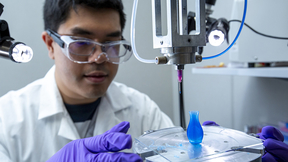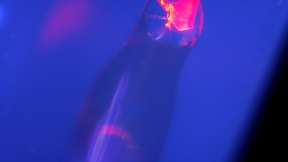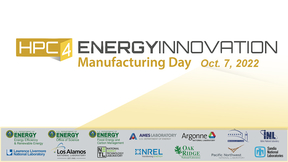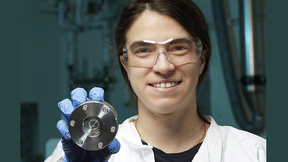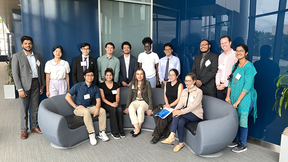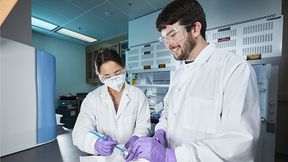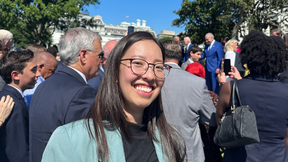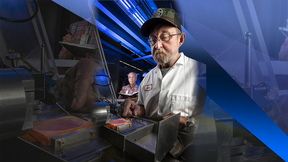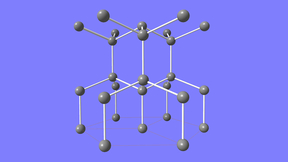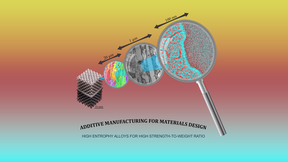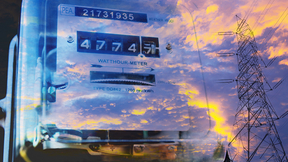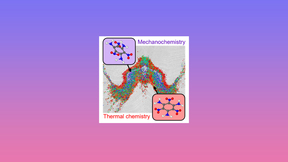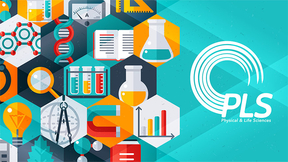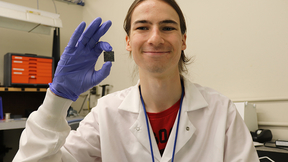Back
Physical and Life Sciences
Livermore researchers collect three awards among the top 100 industrial inventions
Lawrence Livermore National Laboratory (LLNL) scientists and engineers have garnered three awards among the top 100 industrial inventions worldwide. The trade journal R&D World Magazine recently announced the winners of the awards, often called the “Oscars of invention,” recognizing new commercial products, technologies and materials that are available for sale or…
Going big: Unlocking the study of some of the rarest and most toxic elements on Earth
The synthesis and study of radioactive compounds are naturally difficult due to the extreme toxicity of the materials involved, but also because of the cost and scarcity of research isotopes. Now, Lawrence Livermore National Laboratory (LLNL) scientists and their collaborators at Oregon State University (OSU) have developed a new method to isolate and study in great detail…
Manufacturing Day webinar to highlight HPC’s impact on climate change, energy efficiency
The High Performance Computing for Energy Innovation (HPC4EI) initiative will hold a special webinar on Oct. 7 to celebrate Manufacturing Day and provide a forum for industry experts and Department of Energy (DOE) scientists to discuss how HPC can help combat climate change and improve energy efficiency. The virtual event begins at 8 a.m. PDT and brings together panelists…
Asteroid sample lands on LLNL
No need to worry, it is just a very small piece for scientific study. In December 2014, the Japanese Aerospace Exploration Agency launched the spacecraft Hayabusa2 to the asteroid 162173 Ryugu. In December 2020, when the sample-return capsule successfully landed safely back on Earth with pristine pieces of Ryugu that it had collected, Lawrence Livermore National Laboratory…
LLNL and Korea Institute of Science and Technology to collaborate
Leaders at Lawrence Livermore National Laboratory (LLNL) and the Korea Institute of Science and Technology (KIST) signed a memorandum of understanding (MOU) on Monday to collaborate on basic science and technology in the renewable energy, climate science, data science and characterizations arenas. Under the MOU, KIST will have office space in the Livermore Open Campus…
LLNL and Case Western Reserve University to continue collaboration
The leaders of Case Western Reserve University and Lawrence Livermore National Laboratory (LLNL) signed a memorandum of understanding (MOU) to accelerate their efforts in shared areas of excellence. After three years of growing institutional collaboration in such areas as energy, materials science and polymer processing, Case Western Reserve President Eric W. Kaler…
Understanding how radionuclides move
Lawrence Livermore National Laboratory (LLNL) intern Jordan Stanberry is spending his summer examining pond sediments to better understand groundwater contamination from decades-old nuclear tests. A chemistry graduate student from the University of Central Florida (UCF), Stanberry is participating in an eight-week Glenn T. Seaborg Institute (GTSI) internship program. The…
White House visit underscores a national need for diversity in STEM
This week, President Biden signed into law the bipartisan bill known as the CHIPS and Science Act (CSC ACT). The bill aims to strengthen U.S. competition by encouraging U.S. companies to manufacture semiconductors and by revitalizing “America’s scientific research and technological leadership." Under Title V: Broadening Participation in Science of the bill, the White House…
Going deep: New ground motion model more accurately simulates earthquakes, explosions
Lawrence Livermore National Laboratory (LLNL) scientists have created a new adjoint waveform tomography model that more accurately simulates earthquake and explosion ground motions. The paper, published in the Journal of Geophysical Research, was selected for an Editor’s Highlight. Seismic tomography is a method to estimate the inaccessible three-dimensional (3D) seismic…
Lab’s technology on board James Webb Space Telescope
Last month, NASA’s James Webb Space Telescope (JWST), a partnership with the European Space Agency and the Canadian Space Agency, revealed unprecedented and detailed views of the universe, with the release of its first full-color images and spectroscopic data. The cosmic objects that Webb targeted for these first observations were released July 12 and are available on the…
Three peer-reviewed papers highlight scientific results of National Ignition Facility record yield shot
After decades of inertial confinement fusion research, a yield of more than 1.3 megajoules (MJ) was achieved at Lawrence Livermore National Laboratory’s (LLNL’s) National Ignition Facility (NIF) for the first time on Aug. 8, 2021, putting researchers at the threshold of fusion gain and achieving scientific ignition. On the one-year anniversary of this historic achievement,…
Graphite changes to hexagonal diamond in picoseconds
The graphite-diamond phase transition is of particular interest for fundamental reasons and a wide range of applications. On very fast compression time scales, material kinetics hinder the transition from graphite to the equilibrium cubic diamond crystal structure that we commonly know as diamond. Shock wave compression of graphite typically requires pressures above 50 GPa…
New class of 3D-printed alloys brings more flexibility to super-strong metal parts
Metal 3D printing is used to produce components for many commercial applications, particularly in the transportation sector, where printing methods such as laser powder bed fusion (L-PBF) can produce super-strong and ultralight complex-shaped components that cannot be manufactured with conventional techniques. But while laser-based methods enable the manufacturing of…
An open-source, data-science toolkit for energy GridDS
As of 2020, 102.9 million smart meters — devices that record and communicate electric consumption, voltage and current to consumers and grid operators — have been installed in the United States. As the number of smart meters and the demand for energy is expected to increase by 50 percent by 2050, so will the amount of data those smart meters produce. While energy standards…
Research finds mechanically driven chemistry accelerates reactions in explosives
Scientists at the Lawrence Livermore National Laboratory (LLNL) Energetic Materials Center and Purdue University Materials Engineering Department used simulations performed on the LLNL supercomputer Quartz to uncover a general mechanism that accelerates chemistry in detonating explosives critical to managing the nation’s nuclear stockpile. Their research is featured in the…
Fabricating iron oxide with high phase purity
Various types of iron oxide (FeO) are typically distinguished by the number of iron and oxygen atoms coordinated with one another. However, specific iron and oxygen coordination is also an important factor to consider, as a molecule’s various phases can exhibit vastly different material properties. In recent years, epsilon-phase iron oxide (ε-Fe2O3), a rare polymorph of…
3D printing of transparent silicone elastomers
Additive manufacturing is essential to the production of advanced materials, providing a straightforward approach to rapid prototyping and manufacturing. Direct ink writing (DIW), a subset of additive manufacturing, offers a versatile route to ink extrusion—a processing method where a viscous ink is forced through a nozzle but behaves like a solid when printed on a…
Performing a cross-scaffold search for genomic islands
Gareth Trubl and researchers from Sandia National Laboratories have created a new computer tool called Tiger2 that scans DNA and looks for genomic islands—sections that look different than the surrounding DNA. Genomic islands are important for understanding life, infection, evolution, and more. These sections typically house antibiotic resistant and toxin producing genes…
Research reveals where carbon storage in soils has the most potential
Soil is the largest terrestrial reservoir of organic carbon and is central for climate change mitigation and adaptation. Mineral-organic associations play a critical role in soil carbon preservation, but the global capacity for storage in this form has never been quantified. New research from Lawrence Livermore National Laboratory (LLNL) and an international team of…
LLNL intern fabricates carbon aerogel structures for energy-storage applications
A visit to Lawrence Livermore National Laboratory (LLNL) last summer by a university professor led to a unique internship opportunity for an undergraduate student this summer: helping LLNL scientists fabricate higher-performing carbon aerogel structures for electrodes and other energy-storage applications. In 2021, Professor Anthony Santamaria from Western New England (WNE…


